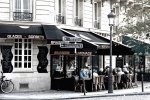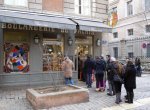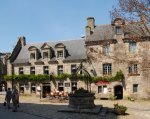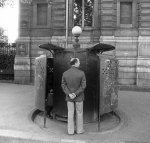the bastides of aveyron
There are hundreds of bastides in France, but those in Aveyron are especially noteworthy, and can be explored in a stay of just a few days, although the chances are that you'll stay longer.
Rapid population growth and the need to effect better control of the development of the region of south-west France known as the ‘Rouergue’ – originally the homeland of a Celtic tribe (the ‘Rutheni’) – brought about the medieval equivalent of a rural development policy. It began a period of town building by king and count alike which was to last for 150 years, from 1229 until 1373, during which over 300 bastides, or ‘new towns’ were built. Five are in the department of Aveyron.
In spite of their number, and many common characteristics, the bastides retain individuality and are fascinating towns to visit. They were invariably built on a hilltop, or some other easily defensible position, and had a fortified perimeter. Most usual of all, they were built to a rectangular grid layout, with narrow alleys (carreyous) for access to backs of houses and their gardens, and a narrow separating gap (andrones) between houses to limit the spread of fire and enable rain and waste water disposal. Typically, bastides were built around a market square, often with a covered section (les halles) or covered arcades (cornières) built out of the ground floor of the houses surrounding the square.
Villeneueve
d’Aveyron
At Villeneuve d‘Aveyron the town was grafted onto a Romanesque
monastery, and later became one of a small number of bastides royales used
as a royal base during the construction of the other towns. Of all those in
Aveyron, Villeneuve does not follow the characteristic rectangular layout, but
rather has a network of narrow roads radiating from the central church. Lovely
arcades feature around the tiny village centre, from which carreyous seem
to run in all directions.
Najac
Perched on a steep-sided hill in the south-west of the département,
the 13th-century fortress town of Najac dominates
the wild gorges of the Aveyron. Najac is one of many villages embroiled in the
early 13th-century religious saga of the Cathars, the ‘Good Men’, as they were
called, of a breakaway religious following persecuted by the Pope and his
agents, and, in the case of Najac, condemned to build the church of St Jean at
their own expense. They were the lucky ones; many died in flames for their
belief.
The village, one of the most beautiful in France, is essentially one long street perched on a ridge. Its timber-framed houses have a relaxed air about them, leaning companionably on their neighbours for essential support. The walk to the castle precincts is well worth the effort, such as it is, for it gives a splendid view both of the village and the surrounding Aveyron countryside.
Villefranche de
Rouergue
To the north of the River Aveyron, the town of Villefranche de Rouergue
was founded in 1252 by the Count of Toulouse, Alphonse de Poitiers. Here the
town follows the typical plan: regular in layout with narrow
streets intersecting at right angles and leading to a central square bordered
by arcades which today are the focal point of a colourful and lively market.
Central to the town is the huge church, which literally dominates everything.
La Bastide l’Évêque
La Bastide l’Évêque was founded in 1280 by the Bishop of Rodez as a
rival to Villefranche, and is built on a plateau overlooking the Aveyron
valley. Here the design has greater simplicity made possible by its more
isolated position. Compared with the other bastides of
Aveyron, this is the smallest, and few of its original defences are evident,
though the main entrance archway is singularly impressive. This is a quiet
place, off the beaten track, and a delight to visit.
Sauveterre-de-Rouergue
Like Najac, Sauveterre-de-Rouergue is classed as one of the most beautiful French villages it was founded on monastery land in 1281 by
King Philippe, and is arguably the finest example of a bastide,
with ramparts, ancient gateways, narrow streets and forty-seven delightful
arcades around a central market place. Today, the village is witnessing a
revival of traditional trades and skills with the growth of artisanats producing
bags, knives, tapestries, hats, floral decorations, wrought-iron metalwork and
leather goods.
TOURIST INFORMATION
Association des Bastides du Rouergue
Maison de
Tourisme, Anciens Bains-Douches, 12200 Villefranche de Rouergue.
Comité Départmental du Tourisme d’Aveyron
17
rue Aristide Briand, BP 831, 12008 RODEZ.
Tel: 05 65 75 40 12
www.tourisme-aveyron.com
Recent Articles
-
French Food and Drink - No BS Guide for lovers of Food, Wine, Liqueurs
Aug 28, 19 03:18 AM
Our guide to French food and drink for those who love traditional French food along with our no BS guide to understanding French wine and liqueurs
-
Things To Do In Carcassonne The Ultimate Tourist Guide
Aug 24, 19 06:26 PM
The ultimate tourist guide to things to do in Carcassonne when you visit this wonderful town in Aude France. Discover the places to go and see in Carcassone.
-
Lyon Old Town Guide to Vieux Lyon
Aug 18, 19 07:48 AM
Your complete guide to Lyon old town otherwise known as the Vieux Lyon. Don't miss this amazing part of the city if you're visiting Lyon in France.
-
18 French Villages You Must Visit Most Beautiful Villages in France
Aug 17, 19 06:31 AM
Our guide to the 18 most beautiful French villages you simply must visit. Loads of info, photos and facts in our ultimate villages in France tourist guide
-
What a Pissoir - The True Story of France's Unique Urinals
Aug 13, 19 03:47 PM
Is there anything more French than a pissoir? Sadly on the decline nevertheless the pissor is an endring image of the country. This is their story





